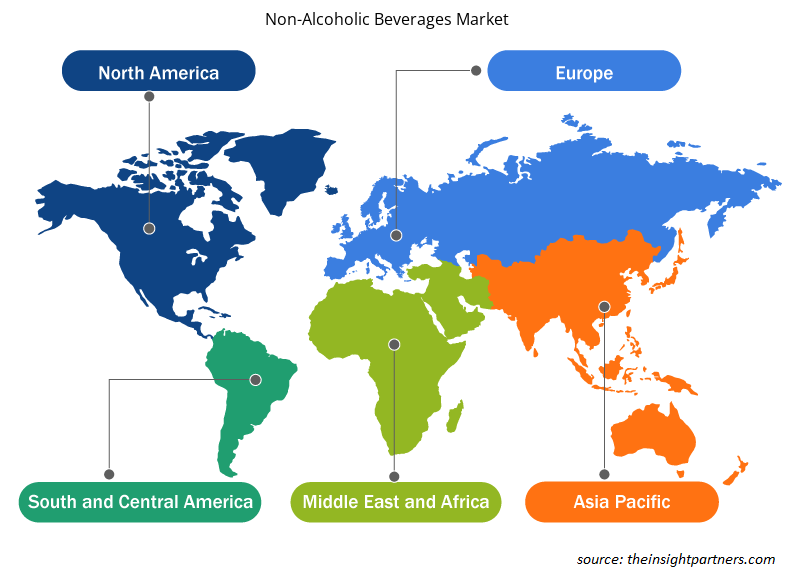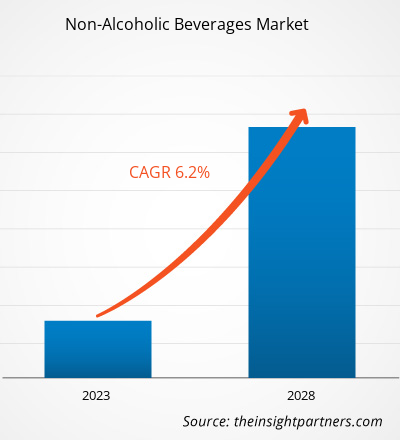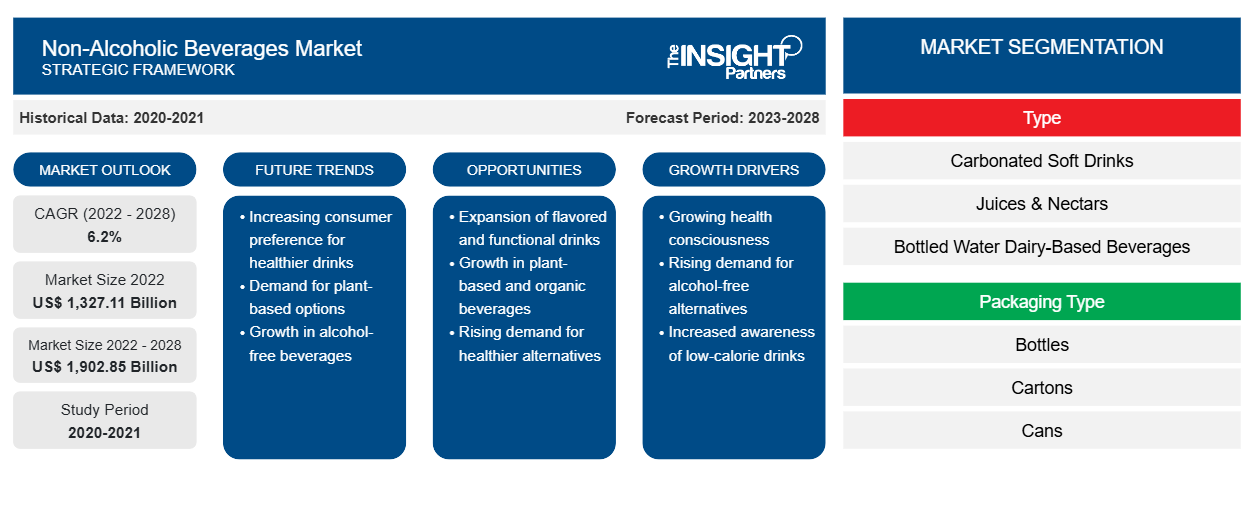Si prevede che il mercato delle bevande analcoliche crescerà da 1.327,11 miliardi di dollari nel 2022 a 1.902,85 miliardi di dollari entro il 2028. Si stima che crescerà a un CAGR del 6,2% dal 2022 al 2028.CAGR of 6.2% from 2022 to 2028.
Bibite analcoliche gassate, acque in bottiglia, succhi e nettari, bevande a base di latticini e alternative ai latticini, tè e caffè RTD e bevande energetiche sono i diversi tipi di bevande analcoliche disponibili sul mercato. La categoria senza zucchero sta guadagnando una notevole popolarità tra i consumatori a causa dell'aumento dei problemi di salute e dell'elevata prevalenza di obesità, diabete e malattie cardiache in vari paesi del mondo. Le bevande funzionali e le bevande fortificate stanno assistendo a una forte domanda a causa della crescente attenzione alla salute e alla nutrizione. Le bevande analcoliche al malto e le premiscele sono ampiamente consumate nei paesi del Medio Oriente come Arabia Saudita, Iran ed Emirati Arabi Uniti a causa delle rigide normative sul consumo di bevande alcoliche e delle bevande al malto che ottengono certificazioni halal. Questo fattore sta alimentando la crescita del segmento delle bevande analcoliche al malto nel mercato globale delle bevande analcolichenectars, dairy-based and dairy alternative beverages, RTD tea and coffee, and energy drinks are the different types of non-alcoholic beverages available in the market. The sugar-free category is gaining significant traction among consumers due to the rise in health concerns and the high prevalence of obesity, diabetes, and heart diseases in various countries across the globe. Functional drinks and fortified beverages are witnessing high demand due to the growing focus on health and nutrition. Non-alcoholic malt beverages and premixes are widely consumed in Middle Eastern countries such as Saudi Arabia, Iran, and the UAE owing to the strict regulations on alcoholic beverage consumption and malt beverages getting halal certifications. This factor is fueling the growth of the non-alcoholic malt beverages segment in the global
Nel 2021, l'Asia Pacifica ha detenuto la quota di fatturato maggiore del mercato globale delle bevande analcoliche. I principali fattori che guidano il mercato nell'Asia Pacifica sono la crescente consapevolezza della salute tra i consumatori, l'elevata domanda di bevande alternative al latte e la crescente popolarità dei succhi di frutta naturali e biologici. In paesi come Giappone e Corea del Sud, la maggior parte della popolazione è intollerante al lattosio. Questo fattore sta aumentando la popolarità delle bevande alternative al latte nei paesi. Inoltre, il mercato delle bevande analcoliche dell'Asia Pacifica è redditizio grazie alla presenza di una potenziale base di consumatori, alla forte domanda di bevande salutari e all'ampio panorama della vendita al dettaglio. La categoria NOLO (birre, liquori e cocktail analcolici/a basso contenuto alcolico) sta riscontrando una domanda significativa nell'Asia Pacifica a causa delle mutevoli abitudini di consumo e della crescente attenzione dei consumatori verso un'alimentazione e un consumo sani. Pertanto, molte aziende emergenti che offrono birre e liquori analcolici o a basso contenuto alcolico stanno espandendo la loro presenza nell'Asia Pacifica. Ad esempio, Sipfree, una piattaforma di shopping online per birre, liquori e vini analcolici, è stata lanciata a Hong Kong nel gennaio 2020 e, nonostante lo scoppio del COVID-19, le vendite di Sipfree sono aumentate notevolmente. Si prevede che tali espansioni apriranno opportunità redditizie nella crescita del mercato delle bevande analcoliche dell'Asia Pacifica nel periodo di previsione.
Personalizza questo report in base alle tue esigenze
Riceverai la personalizzazione gratuita di qualsiasi report, comprese parti di questo report, o analisi a livello nazionale, pacchetto dati Excel, oltre a usufruire di grandi offerte e sconti per start-up e università
-
Scopri le principali tendenze di mercato in questo rapporto.Questo campione GRATUITO includerà analisi di dati che spaziano dalle tendenze di mercato alle stime e alle previsioni.
Impatto della pandemia di COVID-19 sul mercato delle bevande analcoliche
Nel periodo pre-pandemia, il mercato delle bevande analcoliche era guidato principalmente dall'elevata domanda di bevande salutari e bevande da asporto. Tuttavia, a causa dello scoppio del COVID-19 nel 2020, molti settori hanno dovuto affrontare sfide senza precedenti. I produttori di alimenti e bevande hanno assistito a una lenta crescita nella fase iniziale della pandemia a causa della chiusura delle unità di produzione e delle interruzioni della catena di fornitura. Tuttavia, un cambiamento nello stile di vita dei consumatori, un aumento della preferenza per pratiche alimentari sane e un aumento della popolazione attenta alla salute hanno promosso sostanzialmente la domanda di bevande analcoliche. La domanda di bevande a base vegetale come latte di soia, mandorle e cocco è raddoppiata dopo la pandemia, poiché i consumatori ritengono che le bevande a base vegetale offrano un valore nutrizionale maggiore rispetto a quelle convenzionali. Secondo il rapporto Mintel pubblicato a giugno 2020, il 25% dei consumatori intervistati nel Regno Unito ha concordato che una dieta vegana sembrava allettante a causa della pandemia. Questi fattori hanno avuto un impatto positivo sulla crescita del mercato delle bevande analcoliche.
Le tendenze di salute e benessere sono state innescate dopo lo scoppio del COVID-19. I consumatori si stanno dedicando a varie attività di fitness come yoga, jogging e ciclismo per mantenersi in salute. Si prevede che questo fattore fornirà un forte potenziale al mercato delle bevande analcoliche, in particolare nel settore delle bevande energetiche e sportive , nei prossimi anni.
Approfondimenti di mercato
L'adozione crescente di bevande sportive guiderà il mercato delle bevande analcoliche
L'alimentazione svolge un ruolo significativo nel migliorare le prestazioni sportive. Atleti e sportivi devono seguire un'alimentazione adeguata per soddisfare il loro fabbisogno giornaliero di energia e nutrienti. Oltre ad atleti professionisti e sportivi, molte persone sono impegnate in attività fisica quotidiana per mantenere la loro salute generale. Il numero di appassionati di fitness è aumentato negli ultimi anni a causa delle crescenti preoccupazioni per la salute e il benessere. Le bevande sportive ripristinano il livello di elettroliti, acqua ed energia persi durante l'esercizio e le attività fisiche. Queste bevande contengono in genere carboidrati, potassio, sodio, magnesio e calcio che servono a reidratare, ripristinare le riserve di glicogeno e ritardare l'affaticamento dopo l'esercizio. Le crescenti preoccupazioni per la salute e il fitness e un numero crescente di appassionati di sport sono i fattori chiave che guidano le vendite di bevande sportive a livello globale. Pertanto, la crescente adozione di bevande sportive sta guidando in modo significativo il mercato delle bevande analcoliche.sportspersons must follow adequate nutrition to meet their daily energy and nutrients demand. Along with professional athletes and sportspersons, many people are engaged in daily physical activity to maintain their overall health. The number of fitness enthusiasts increased in recent years due to increased health and wellness concerns. Sports drinks replenish the level of electrolytes, water, and energy lost during exercise and physical activities. These drinks typically contain carbohydrates, potassium, sodium, magnesium, and calcium that serve to rehydrate, replenish glycogen stores, and delay fatigue after exercise. The rising health and fitness concerns and an increasing number of sports enthusiasts are the key factors driving the sales of sports drinks globally. Thus, the rising adoption of sports drinks is significantly driving the non-alcoholic beverages market.
Tipo Informazioni
In base al tipo, il mercato globale delle bevande analcoliche è stato segmentato in bevande analcoliche gassate, acque in bottiglia, succhi e nettari, bevande a base di latticini, bevande alternative ai latticini, tè e caffè RTD, birre analcoliche, bevande al malto e altri. Il segmento dei succhi e nettari è ulteriormente suddiviso in succhi di frutta frizzanti e altri. Il segmento delle bevande analcoliche gassate ha detenuto la quota maggiore del mercato globale delle bevande analcoliche nel 2021 e si prevede che il segmento delle bevande alternative ai latticini crescerà al CAGR più rapido nel periodo di previsione. Le bevande analcoliche gassate sono bevande analcoliche frizzanti realizzate con acqua pulita, zucchero, dolcificanti naturali o alternative allo zucchero (nelle bevande dietetiche), caffeina, ingredienti aromatizzanti artificiali, concentrazioni di succhi di frutta, conservanti e additivi coloranti. Sprite, Coca-Cola, Mountain Dew e Monster sono alcuni dei marchi di bevande analcoliche più noti in tutto il mondo. Le bevande analcoliche gassate sono ampiamente disponibili nei minimarket, supermercati e ipermercati, distributori automatici, cinema, negozi di bibite e negozi al dettaglio online. Il cambiamento degli stili di vita dei consumatori, l'aumento del reddito disponibile e la crescente domanda di cibi e bevande pronti stanno guidando il mercato per il segmento delle bevande analcoliche gassate.
Approfondimenti sulla categoria
In base alla categoria, il mercato globale delle bevande analcoliche è stato suddiviso in senza zucchero e convenzionali. Il segmento convenzionale ha detenuto una quota di mercato maggiore nel 2021. La crescente prevalenza di obesità, diabete, ipertensione e malattie cardiovascolari spinge la domanda di bevande senza zucchero. Secondo la Federazione Internazionale del Diabete, circa 537 milioni di persone in tutto il mondo soffrivano di diabete nel 2021. Molti produttori di bevande stanno sviluppando proattivamente prodotti con dolcificanti naturali ipocalorici per soddisfare la crescente domanda di bevande senza zucchero. Questo fattore sta guidando il mercato per il segmento.
Approfondimenti regionali sul mercato delle bevande analcoliche
Le tendenze regionali e i fattori che influenzano il mercato delle bevande analcoliche durante il periodo di previsione sono stati ampiamente spiegati dagli analisti di Insight Partners. Questa sezione discute anche i segmenti e la geografia del mercato delle bevande analcoliche in Nord America, Europa, Asia Pacifico, Medio Oriente e Africa e America centrale e meridionale.

- Ottieni i dati specifici regionali per il mercato delle bevande analcoliche
Ambito del rapporto sul mercato delle bevande analcoliche
| Attributo del report | Dettagli |
|---|---|
| Dimensioni del mercato nel 2022 | 1.327,11 miliardi di dollari USA |
| Dimensioni del mercato entro il 2028 | 1.902,85 miliardi di dollari USA |
| CAGR globale (2022 - 2028) | 6,2% |
| Dati storici | 2020-2021 |
| Periodo di previsione | 2023-2028 |
| Segmenti coperti |
Per tipo
|
| Regioni e Paesi coperti |
America del Nord
|
| Leader di mercato e profili aziendali chiave |
|
Densità degli attori del mercato delle bevande analcoliche: comprendere il suo impatto sulle dinamiche aziendali
Il mercato delle bevande analcoliche sta crescendo rapidamente, spinto dalla crescente domanda degli utenti finali dovuta a fattori quali l'evoluzione delle preferenze dei consumatori, i progressi tecnologici e una maggiore consapevolezza dei benefici del prodotto. Con l'aumento della domanda, le aziende stanno ampliando le loro offerte, innovando per soddisfare le esigenze dei consumatori e capitalizzando sulle tendenze emergenti, il che alimenta ulteriormente la crescita del mercato.
La densità degli operatori di mercato si riferisce alla distribuzione di aziende o società che operano in un particolare mercato o settore. Indica quanti concorrenti (operatori di mercato) sono presenti in un dato spazio di mercato in relazione alle sue dimensioni o al valore di mercato totale.
Le principali aziende che operano nel mercato delle bevande analcoliche sono:
- La Coca-Cola Company
- PepsiCo
- Annidarsi
- Toro Rosso
- Società a responsabilità limitata
Disclaimer : le aziende elencate sopra non sono classificate secondo un ordine particolare.

- Ottieni una panoramica dei principali attori del mercato delle bevande analcoliche
I principali attori che operano nel mercato globale delle bevande analcoliche includono The Coca Cola Company, PepsiCo, Nestle, Red Bull, Suntory Holdings Limited, Danone SA, Califia Farms LLC, Keurig Dr Pepper Inc, Asahi Group Holdings Limited, Bolthouse Farms Inc., Heineken NV, Coolberg Beverages Pvt Ltd, Goya Foods Inc, Anheuser-Busch InBev NV e Carlsberg AS. Gli attori che operano nel mercato globale delle bevande analcoliche si stanno concentrando sulla fornitura di prodotti biologici, senza OGM, a base vegetale e senza glutine con nuovi gusti per soddisfare le mutevoli esigenze dei consumatori. Ad esempio, nel 2019, Coca-Cola Europacific Partners ha lanciato due succhi frizzanti nella sua gamma Honest Organic Lemonade. Il prodotto è realizzato con succo di frutta biologico e zucchero, mentre non contiene dolcificanti o aromi artificiali. Si prevede che tali prodotti innovativi otterranno un'enorme trazione da parte dei consumatori, guidando la crescita del mercato delle bevande analcoliche.
Segnala i riflettori
- Tendenze progressive del settore nel mercato delle bevande analcoliche per aiutare gli operatori a sviluppare strategie efficaci a lungo termine
- Strategie di crescita aziendale adottate dai mercati sviluppati e in via di sviluppo
- Analisi quantitativa del mercato delle bevande analcoliche dal 2020 al 2028
- Stima della domanda globale di bevande analcoliche
- Analisi delle cinque forze di Porter per illustrare l'efficacia degli acquirenti e dei fornitori che operano nel settore
- Sviluppi recenti per comprendere lo scenario competitivo del mercato
- Tendenze e prospettive del mercato, nonché fattori che guidano e frenano la crescita del mercato delle bevande analcoliche
- Assistenza nel processo decisionale evidenziando le strategie di mercato che sostengono l'interesse commerciale, portando alla crescita del mercato
- La dimensione del mercato delle bevande analcoliche nei vari nodi
- Panoramica dettagliata e segmentazione del mercato, nonché dinamiche del settore delle bevande analcoliche
- Dimensioni del mercato delle bevande analcoliche in diverse regioni con promettenti opportunità di crescita
- Analisi storica (2 anni), anno base, previsione (7 anni) con CAGR
- Analisi PEST e SWOT
- Valore/volume delle dimensioni del mercato - Globale, Regionale, Nazionale
- Industria e panorama competitivo
- Set di dati Excel
Report recenti
Rapporti correlati
Testimonianze
Motivo dell'acquisto
- Processo decisionale informato
- Comprensione delle dinamiche di mercato
- Analisi competitiva
- Analisi dei clienti
- Previsioni di mercato
- Mitigazione del rischio
- Pianificazione strategica
- Giustificazione degli investimenti
- Identificazione dei mercati emergenti
- Miglioramento delle strategie di marketing
- Aumento dell'efficienza operativa
- Allineamento alle tendenze normative























 Ottieni un campione gratuito per - Mercato delle bevande analcoliche
Ottieni un campione gratuito per - Mercato delle bevande analcoliche